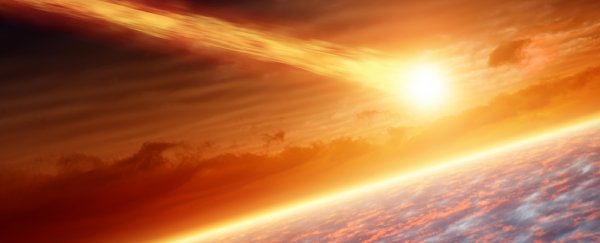When an asteroid hit Earth some 66 million years ago, it triggered devastation around the world.
There were at least three nearly simultaneous events involved in the global catastrophe that ended what we now call the Mesozoic era.
An asteroid between 10 and 15 kilometres in diameter slammed into Earth, creating the Chicxulub Crater near Mexico's Yucatan Peninsula.
The Deccan Traps, a massive volcanic province in what's now India, erupted, spewing lava and smoke that filled the skies.
And 75 percent of Earth's plant and animal life went extinct, which scientists have linked to those other disasters that filled the skies with soot and smoke and transformed the world's climate.
But when it comes to world-shaking devastation, that wasn't all that was going on at the time, scientists report in a study recently published in the journal Science Advances.
The asteroid also appears to have sent ripples through Earth's tectonic plates, which spread out through the oceans and caused tens of thousands of miles of underwater volcanic ridges to spew magma.
The authors describe those eruptions as "on par with the largest eruptive events in Earth's 4.5-billion-year history, including the Deccan Traps".
Looking for past volcanic activity
Part of the debate about what really killed the dinosaurs has to do with the interplay between the asteroid impact and the Deccan Traps eruptions. The most up-to-date understanding suggests the Deccan Traps eruptions began before the Chicxulub impact.
But they also seem to have gotten much more active in the time after the asteroid hit.
Yet if the asteroid was able to influence volcanic activity on the other side of the globe, it should have affected volcanoes elsewhere, too. That's why the authors of this study decided to trace what was happening in the oceans.
To uncover evidence of underwater volcanic activity, the researchers used existing data to examine how the seafloor's structure changed over the past 100 million years.
They were able to find evidence of massive transformations in the amount of rock on the seafloor, a change caused by volcanic activity.
Eruptions left 650-foot-high piles of rock in the Indian and Pacific oceans, the study authors write in The Conversation. They dated those eruptions to within a million years of the impact, close enough to link the events.
A better picture of the dinosaur apocalypse
These new findings give us a better timeline of what happened to trigger the Cretaceous-Paleogene extinction event.
Although the Deccan Traps were probably erupting for 250,000 years before the Chicxulub asteroid slammed into the planet, the impact transformed the world.
The atmosphere filled with soot, causing global cooling that was strong and sudden enough to have played a strong role in the end of the dinosaurs.
At the same time, the asteroid shook the world and led to earthquakes that released even more magma.
The already flowing Deccan Traps erupted in a whole new way, essentially covering the Indian subcontinent with lava and further filling the skies with particles that reflected the sun's heat back into space and cooled the planet.
An eruption that was equally strong occurred underwater.
Small mammals and flying dinosaurs – which we now know as birds – survived, but the majority of plant and animal life did not.
We still don't know exactly which components of these global catastrophes were most responsible for the extinctions, or whether other volcanic systems elsewhere in the world were triggered, too.
"What is clear is that this new research points to global-scale connections between catastrophes, a good reminder that events happening on the other side of the planet can have effects felt everywhere," the study authors write.
What is very clear is that this was an unpleasant time to be anywhere on Earth.
This article was originally published by Business Insider.
More from Business Insider:
